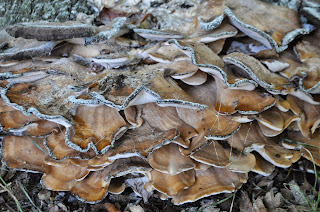Sometimes it’s just a question of a new way of looking. Once you’re in the habit of becoming more aware of your surroundings, it’s amazing what you can see when you’re out for a weekend's
walk. My son pointed out some mushrooms growing in the woodlands one Saturday
and ever since then I’ve been on the look-out for these incredible fungi. I’ve suddenly
discovered them everywhere. I’ve never seen so many.
Choose a damp but clear and sunny day and you're sure to come across some. We stumbled upon this colony of delicate mushrooms, shooting up from the ground, their thin stalks with their pale white hoods made them look quite incredible.
Walking around the woods in Wimbledon, we could see the effects of St Jude, one of the worst storms to hit south England on the 28th October with winds of up to 99mph. Thousands of trees fell across the country and we could see huge trunks lying on the ground with their roots on show.
In fact fungi seem to love growing on the decaying wood of a fallen tree or branch. Whilst the wood has fallen, the fungi are in their element.
Over a couple of weekends we have found an amazing diversity of forms, shapes, textures, colours and sizes of fungi. Some are perfect and delicate with thin stalks and little hoods and gills, where as others are big and meaty and some are shaped like autumn leaves, whilst others are like jelly or simply slimy looking. I can't seem to stop photographing them, but here are just a few that I have spotted:
Like autumn leaves?
Velvet Shank, looking slimy and slippery
Like rotting meat?
As smooth as a whale's belly
Pretty orange and yellow tiny dots
Black and white tipped straws
These are just some of the photos I have taken over a few weekend's whilst I trampled over the wet and crunchy forest floor. What I didn't realise is that fungi are neither plant nor animal, but are in a separate kingdom all of their own. There are around 100,000 species identified in the world, but it is estimated that there could be around 700,000 to 5 million species according to Kew Gardens.
The mushrooms and toadstools (many highly poisonous)
are the fruiting bodies of the fungi that we can see mainly during autumn. They grow for reproduction purposes to spread their millions of tiny spores, which are usually dispersed like dust in the wind.
It would be fun to use a microscope to see these mushrooms up close.
What's also interesting is I discovered that most fungi can’t be seen as they grow underground, their tiny threads spreading through the soil like roots. The biggest living organism in the world is in fact a fungus called an Armillaria ostoyae. It grows in the Oregon's Blue Mountains and is said to be an amazing 2,384 acres across making it much bigger than the blue whale.
Fungi also have an important function in that they are the 'great decomposers of the environment'. They must be enjoying this time of year when the ground is thick with leaves, branches and mud. They can secrete enzymes and breakdown all the leaves, wood and animal decay on the forest floor. By living in their food they draw nutrients from the organic material and release nutrients and minerals back in to the soil to support new life.
Fungi are also more varied and common than we might first think. If you see mould growing on a piece of bread or an old tomato, then what you are seeing is microscopic fungi spores that have been floating in the air and have landed on the food and began to grow as the food breaks down and rots.
In fact we have used fungi for this purpose to degrade organic compounds in a number of food processes including bread-making, winemaking, blue cheese and even the fermentation of cocoa beans to make chocolate.
Fungi also enter our lives in many other ways which are less pleasant than our culinary delights. Fungi can cause damage to our bodies in ways that include athletes foot and nappy rash and even some pneumonia. The BBC reported that we have around 100 types of fungi living on our body mostly on our feet.
There seems to be so much to discover about the world of fungi. I am surprisingly fascinated by them. Each time I spot a new fungi growing I find myself grabbing my camera. This is a lovely time of year to spot the mushrooms with the leaves gently falling around you and the floor a golden ruddy rich colour. My breath hangs in the fresh damp air as I spot another perfectly formed couple of delicate mushrooms.









.jpg)













.jpg)

























